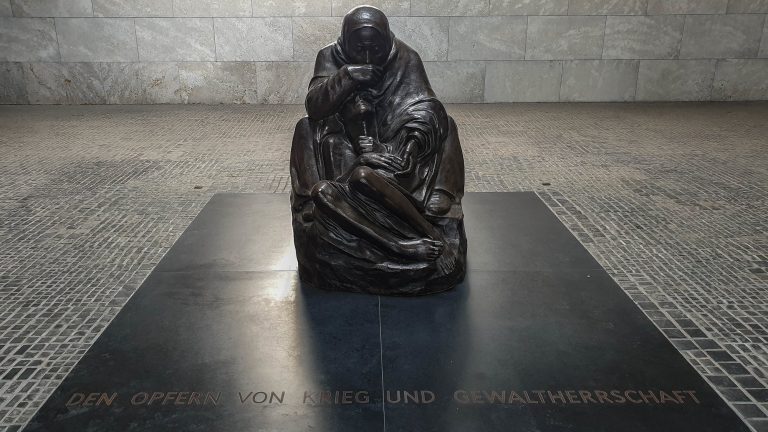Memorials & Monuments in Berlin
Berlin has a dark and complex history, and one way that visitors explore this past is through the numerous memorials. These sites serve as powerful reminders of the people and events that have shaped the city and the world at large. From the iconic Brandenburg Gate to the poignant Memorial to the Murdered Jews of Europe, there is no shortage of monuments and memorials to explore. Other notable memorials include the Soviet War Memorial, which honours the sacrifices of the Red Army during World War II. Whether your interests are history or human rights, or simply looking for a meaningful way to see Berlin’s past, the memorials offer a unique and moving experience that is not to be missed.
Book Burning Memorial, Bebelplatz
Formerly known as Opernplatz (due to the State Opera), this public square had its name changed to Bebelplatz on 31 August in 1947 as a reminder of the Nazi book burnings that began here on the night of 6 May 1933, with the burning of books from the Institute for the Science of Sexuality library. A few nights later this event escalated into similar such actions in university towns around the country on 10 May 1933. An estimated 20,000 books were burned here. A plaque marks the site, as does the installation The Empty Library by Micha Ullman, where a glass plate has been set into the cobblestones that looks onto empty bookcases large enough to hold 20,000 book.

Herbert Baum Memorial
Herbert Baum was chairman of a group of mostly Jewish members who openly challenged national socialism. On 18 May 1942 the group attacked an antisemitic and anti-communist exhibition that was designed by Joseph Goebbels and staged in the Lustgarten of Museumsinsel. The attack was not successful and 20 group members were sentenced to death. Baum himself was arrested on 22 May and tortured to death in the prison at Moabit. This memorial commemorates the actions of Baum and his group in the Lustgarten in May 1942.

Memorial for the Murdered Jews of Europe
In the centre of Berlin, this is Germany’s principal memorial to the six million Jewish victims of the Holocaust. There ae wo parts to the monument. Above ground is the very striking and thought-provoking field of stelae, 2711 in total. Underground is an information centre, which examines the persecution and extermination of Jews across Europe. The memorial is located on what was the death strip of the Berlin Wall. During WWII this area was the very heart of Hitler’s killing machine. Specifically, Goebbel’S villa and bunker were situated in this space.

Memorial to the Persecuted Homosexuals Under National Socialism
Inaugurated in 2008, the memorial to homosexual men and women persecuted by Nazism lies on the eastern edge of Tiergarten directly opposite the Memorial to the Murdered Jews of Europe. The concrete cube, measuring 3.60 m high and 1.90 m wide, is a reference to the Holocaust Memorial. A window into the cube shows a film on loop showing two men hugging and kissing – a reminder that the Nazi’s outlawed such acts of intimacy between members of the same sex in 1935. A nearby information plaque, in German and English, outlines the persecution of homosexual at the hands of the Nazis, and how the end of the war did not bring an end to the discrimination.

Neue Wache (New Guard)
Designed by Karl Friedrich Schinkel as a new guardhouse for what the Kronprinzenpalais (diagonally opposite), the Neue Wache was inaugurated on 18 September 1818 as a memorial to those who had lost their lives in the Napoleonic Wars and the Wars of Liberation. Since 1960, when in East Berlin, it became a memorial to the victims of fascism and militarism. In 1993 it became the reunified nation’s central memorial for all victims of war and tyranny. At the centre of the empty hall is is an enlarged replica of the moving statue Mother with Dead Son by Käthe Kollwitz.

Sinti and Roma Memorial
In a quiet and peaceful corner of Tiergarten, opposite the Reichstag, is a circular basin with a triangle at its centre. Around the rim of the basin the poem Auschwitz by Italian Roma Santino Spinello are engraved. An estimated 50,000 Roma and Sinti men, women and children were persecuted and put to death by the Nazis. An open-air exhibition adds a personal dimension with the biographies of nine members of Roma and Sinti communities around Europe. These are stories of persecution, murder and resistance, and the continued fight for civil rights recognition.

Soviet War Memorial, Treptower Park
One of three Soviet memorials in Berlin to the 80,000 Red Army soldiers who died trying to capture city during the Battle of Berlin. Dedicated 4 years to the day after the end of WWII on 8 May 1949, here 7,000 Russian soldiers are buried. This memorial together with two others in Russia, The Motherland Calls in Volgograd and the Rear-front Memorial in Magnitogorsk, make up a triptych commemorating Soviet’s involvement and losses during the Second World War. The focus of the memorial garden is a 12 m bronze statue of a Soviet soldier carrying a young German child standing with his sword over a broken swastika.

Trains to Life - Trains to Death
Just outside Friedrichstraße train station in Berlin is the Trains to Life – Trains to Death bronze installation by the Israeli architect and sculptor Frank Meisler. The memorial depicts two groups of children that represent the contrasting fate of Jewish children during the Nazi era. On 1 December 1938, 190 children departed from Friedrichstraße station for England under the kindertransport scheme. Many more children were deported to death camps around Europe.










